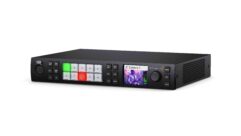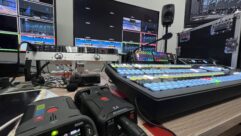
Sound System Design Essentials ? Part 2
Last month, I described the method used to measure spherical loudspeaker data. Why should you care? Room modeling programs operate on some assumptions. It is important to have an abstract understanding of the methods used to collect data to know what can and cannot be predicted about sound system performance. This translates into better designs and fewer surprises.
Last month, I described the method used to measure spherical loudspeaker data. Why should you care? Room modeling programs operate on some assumptions. It is important to have an abstract understanding of the methods used to collect data to know what can and cannot be predicted about sound system performance. This translates into better designs and fewer surprises.
The manufacturer provides loudspeaker data at no cost to the user. There are several file formats. My examples are drawn from the common loudspeaker file format (CLF). A Windows data viewer program and CLF data are available for free download from www.clfgroup.org. Even without a modeling program, much can be learned about loudspeakers from studying these data files.
Polar Plot
A polar plot describes the response of the loudspeaker as it rotates around its axis. The most common polars are the horizontal and vertical, but full, spherical measurements contain many other polars, too. Any “slice” through the data balloon produces a polar.
Spherical balloon data for a popular two-way loudspeaker. The colors indicate the relative sound pressure level at various angles from the source.
Note that the right-hand plot is labeled 1kHz. This means that each point on the polar represents the average response over 1/N-octaves, where N is the frequency resolution of the data. 1/1-octave and 1/3-octave are the most common frequency resolutions. Also note that data only exists at 5-degree intervals, and that these data points are connected with a continuous line to form the plot. Nothing is known about the in-between angles, so the angular resolution must be sufficiently small to not miss any details. Every halving of the angular resolution, such as 10-degree to 5-degree, produces four times the total measurement points, so there is a tradeoff between the angular resolution, measurement time, file size and calculation time.
How to Read a Polar
The key word for understanding a polar plot is “relative.” The on-axis measurement of the loudspeaker provides the reference level for the plot. Let’s say that it is 100dB-SPL. This level becomes 0dB on the polar — a reminder that 0dB in audio can mean many different things, depending on the context in which it is used. It simply establishes a reference against which to compare other things.
Imagine listening to the loudspeaker on-axis, and then having someone slowly rotate it. The SPL will drop from the on-axis level, indicating that the loudspeaker exhibits some control over the radiated sound. The polar plot shows how much the level drops relative to on-axis.
The useful coverage pattern of the loudspeaker is the angle between the -6dB relative levels for a given 1/N-octave band. Some small markers indicate this on the polar plot. The rated horizontal coverage angle of this loudspeaker is 65 degrees, and the rated vertical coverage angle is 45 degrees.
The polar plot is a slice through the balloon that shows how the sound level changes relative to the on-axis position. Horizontal and vertical polars are overlaid here.
Using the Polar
Before the advent of computer modeling, the sound system designer would rely on the polars to determine the SPL at various angles from the loudspeaker. The polar could be overlaid on a room diagram and the zero-degree axis aimed at a listener seat. The on-axis SPL was calculated from the sensitivity (100dB-SPL in my example). The SPL at any angle was determined by considering the angle change from on-axis (0dB on the polar) and the distance differential from on-axis listener seat (from the inverse-square law).
Imagine that the loudspeaker is placed on stage at ear height. If the sound pressure level for the on-axis listener was determined to be 80dB-SPL, it would be 83dB-SPL at a listener seat that is 20 degrees off-axis (-3dB on the polar) and half as far as the axial listener (+6dB). Before computers, this was a tedious task, and usually only a few listener seats were considered.
Polars provide a quick visual for evaluating loudspeaker coverage, but room modeling programs do not use them to determine coverage. This is because the loudspeaker data file the program uses includes information at every n-degree angle around the loudspeaker; remember, we measured an arc from front to back for each 5-degree rotation of the loudspeaker about its axis. The modeling software can calculate the SPL change in any direction by assuming that the sound spreads spherically as it propagates out from the loudspeaker.
This assumption will be correct if the loudspeaker data was gathered in its far-field. The far-field is the distance beyond which the polar (and the radiation balloon) no longer changes shape. If you measured the polar at one foot from a large loudspeaker, and again at two feet from the loudspeaker, the shape likely would be different. But if you keep measuring at greater distances, the shape will stabilize. This is the far-field of the loudspeaker, and it is frequency-dependent. A working approximation of the beginning of the far-field is 10 times the longest dimension of the loudspeaker. In effect, the room modeling program treats the loudspeaker as a “point source with directivity” — an oxymoron, but a useful one.
Array Modeling
The techniques used to model a loudspeaker’s coverage can be extended to its arrays. Since each loudspeaker is a “point source with directivity,” it can be located at a unique position in the model. Other loudspeakers can be added. You can consider the relative level and arrival time (phase) by the modeling program from each point source at any listener position. This allows the complex interaction of the array’s elements to be evaluated for distances beyond the beginning of the far-field for the individual sources.
As long as you remember the far-field dependence of the data, you can expect accurate calculations of audience coverage. Unfortunately, one cannot inspect data after it is gathered to determine if it was measured in the far-field. We are on the honor system with regard to data integrity.
Pat Brown is president of Synergetic Audio Concepts (Syn-Aud-Con) Inc. and Electro-Acoustic Testing Company (ETC) Inc. Syn-Aud-Con conducts training seminars worldwide in audio and acoustics for those who operate, design and install sound reinforcement systems. ETC performs precision loudspeaker tests for the audio industry. Pat can be reached at [email protected].










